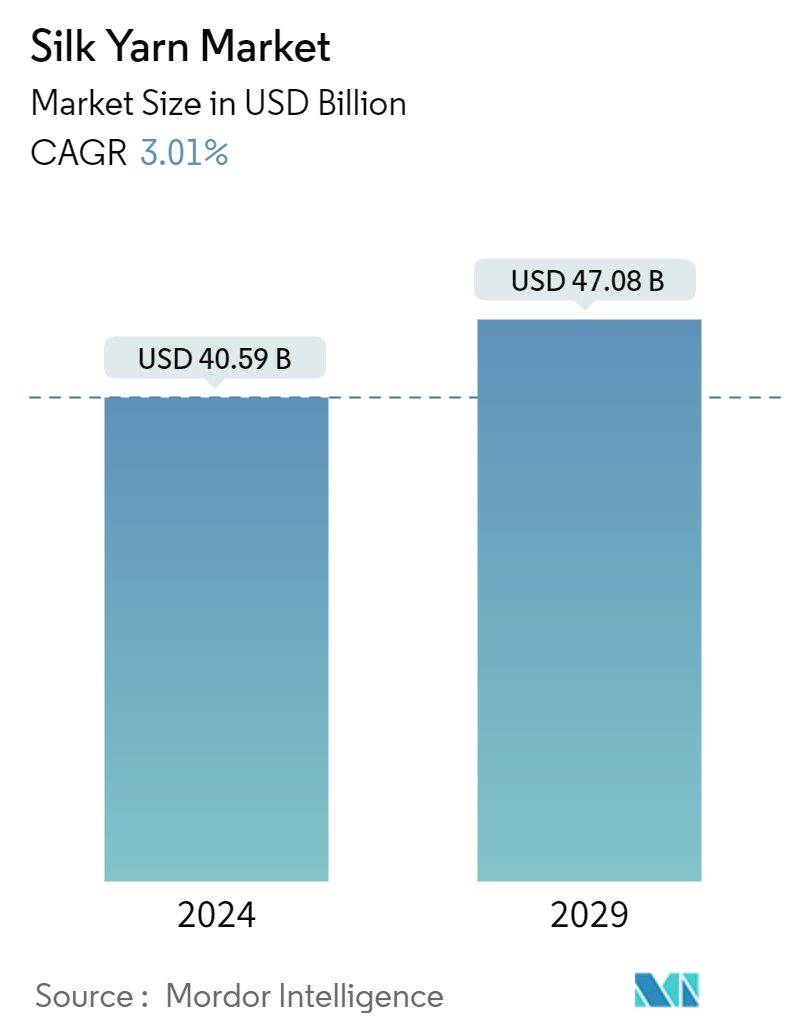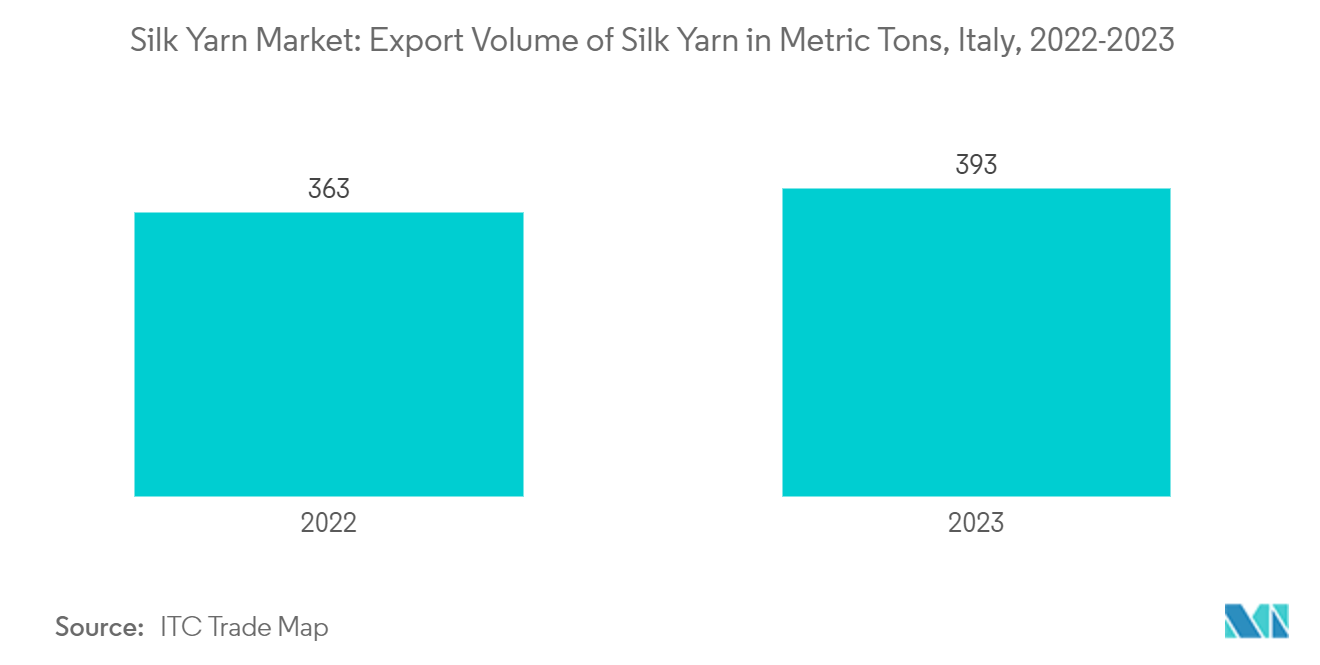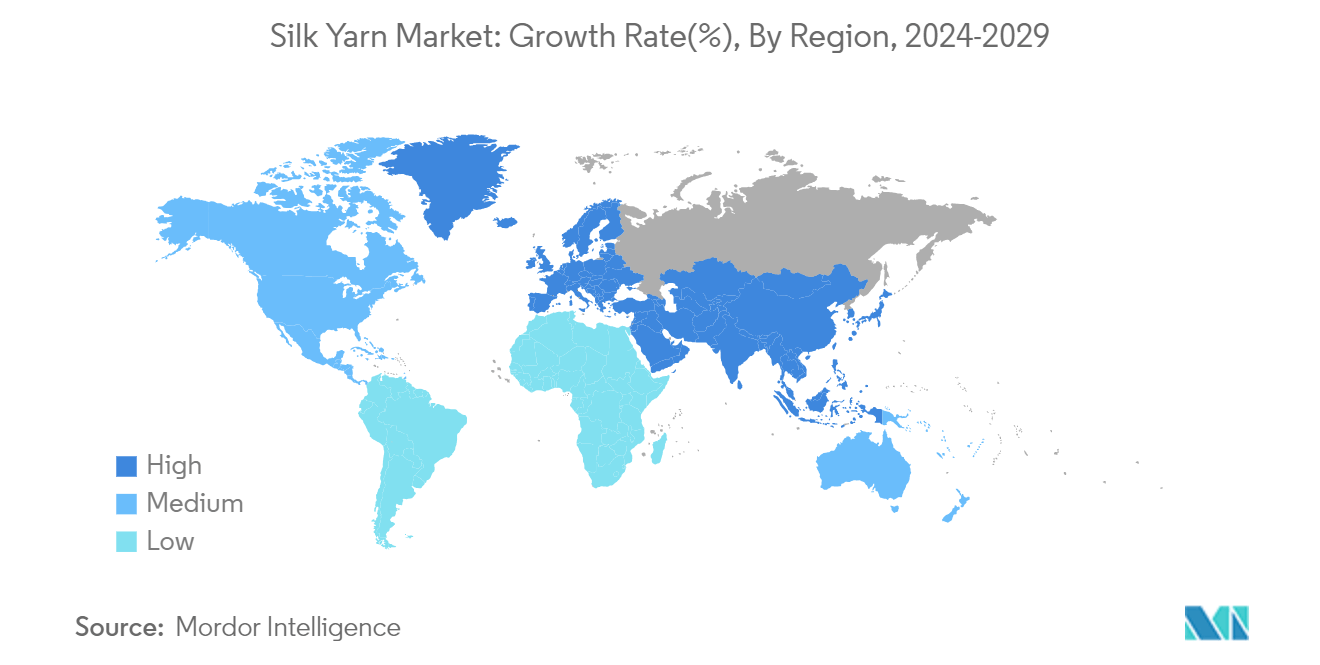Silk Yarn Market Size

| Study Period | 2019 - 2029 |
| Base Year For Estimation | 2023 |
| Forecast Data Period | 2024 - 2029 |
| Market Size (2024) | USD 40.59 Billion |
| Market Size (2029) | USD 47.08 Billion |
| CAGR (2024 - 2029) | 3.01 % |
Silk Yarn Market Analysis
The Silk Yarn Market size is estimated at USD 40.59 billion in 2024, and is expected to reach USD 47.08 billion by 2029, growing at a CAGR of 3.01% during the forecast period (2024-2029).
Silk is one of the world's renowned natural fibers with remarkable tensile strength, extensibility, and exceptional dyeing properties. Its unique continuous filament form sets it apart in the global market. Often associated with luxury, beauty, and elegance, silk's qualities remain unmatched by any other fiber. While silk production spans over 20 countries, Asia dominates the landscape. As reported by the International Sericultural Commission, China is the world's leading silk producer, churning out 50,000 metric tons in 2023, and it is the primary supplier to global markets. Following closely, India, the second-largest producer, produced 38,913 metric tons of silk in 2023. Additionally, sericulture industries have found footing in Brazil, Bulgaria, Egypt, and Madagascar, drawn by the allure of their labor-intensive advantages.
Caribbean countries such as Cuba and African countries, including Kenya, are trying to boost their silk yarn production. The Government of Rwanda has begun investing in the development of silk value chains. With the rising demand from Asia, the production of high-quality silk products offers strong export opportunities. Rwanda's National Agricultural Export Development Board (NAEB) has partnered with HEWorks, a Korean silk manufacturer, to tap into growing global markets. The market is a major provider of foreign exchange reserves in countries such as India. In India, sericulture operations are distributed throughout 52,360 villages. The country uses raw materials to manufacture silk garments, made-ups, textiles, yarns, carpets, shawls, scarves, pillow coverings, and accessories.
The industrialization of the silk industry has transformed it from a labor-intensive craft to a highly efficient and technologically advanced sector. Technological innovations, such as bioengineered silk and sustainable alternatives, tackle pressing environmental and ethical concerns. For instance, in 2024, AMSilk, a silk manufacturing company, produced silk proteins via bacterial fermentation. These proteins were spun into fibers that mimic traditional silk and are biodegradable and devoid of petrochemicals. In addition, the government has rolled out initiatives to bolster silk yarn production and support the broader silk industry. For instance, in 2022, the Indian government launched "Silk Samagra-2", a scheme targeting the comprehensive development of the sericulture industry. This initiative encompasses various components under the Mulberry, Vanya, and post-cocoon sectors to enhance raw silk's quality, productivity, and overall production. Also, it emphasizes job creation, especially in rural locales. Thus, with the industrialization of the silk industry and supportive government schemes, raw silk production is set to surge, leading to an increase in silk yarn production and positioning the region as the dominant market during the forecast period.
Silk Yarn Market Trends
Italy is the Fastest Growing Country in Silk Yarn Export
Italy boasts a storied legacy in silk yarn production, especially in regions like Lombardy and the city of Como, both of which have been celebrated for their silk craftsmanship over the centuries. Known as the "Silk City," Como stands at the forefront of Italy's silk industry. The region's abundant water supply, sourced from Lake Como and nearby Alpine streams and flourishing mulberry farming in the Po River Valley, creates an optimal environment for silk production. Meanwhile, in southern Calabria, the complete silk production unfolds from silkworm breeding to silk spinning, with San Floro taking the lead in preserving age-old silk-making traditions.
Additionally, silk produced in Lucca includes a unique fabric known as drappi auroserici, crafted from a blend of silk and gold or silver threads. The fabric designs prominently feature motifs inspired by both Chinese and Muslim cultures. Predominantly Italian themes adorn these fabrics, showcasing vine leaves, flowers, and naturalistic elements like eagles and other animals, including lions, wolves, and foxes. As Western Europe's appetite for luxury textiles grows, Lucca's economy has seen a corresponding boost. ONGETTA SRL, a notable player, specializes in silk throwing and offers GOTS-certified organic silk under the brand ONGETTA BIO SILK. With Italy's silk manufacturing model wielding significant influence across Europe, it is poised to steer the silk yarn market in the coming years.
Italy plays a pivotal role in the silk market. According to the ITC Trade Map, Italy's silk yarn exports surged to 393 metric tons in 2023, up from 193 metric tons in 2019. The primary destinations for Italian silk exports include France, Romania, Tunisia, the United States, and Germany. In 2023, France emerged as the top importer, receiving 112 metric tons, with an export volume of 112 metric tons, followed by Romania (105 metric tons) and Germany (38 metric tons). Also, the Italian government supports the international promotion of Italian silk through the Italian Trade Agency (ITA). The initiatives span global trade fair participation, targeted marketing campaigns, and bridging connections between Italian producers and worldwide buyers. These endeavors underscore the government's dedication to upholding Italy's esteemed reputation for premium silk and supporting the industry's global presence.

China Dominates the Silk Yarn Production
China is the world's largest producer and exporter of silk and silk products, including silk yarns. However, the rising costs of mulberry cultivation are forcing many farmers to exit sericulture. Silk is mainly produced in the south of the Yangtze River Delta. Renowned silk-producing regions are Jiangsu, Zhejiang, and Sichuan provinces. Cities such as Suzhou, Hangzhou, Nanjing, and Shaoxing are well-known for their silk industries. According to the International Sericultural Organization, China produced 46,700 metric tons of silk in 2022, which increased to 50,000 metric tons in 2023.
China produces 80% of the world's tussah (wild silk) and 50% of the world's supply of silk yarn. Recent technological strides in silk yarn production have bolstered both quality and efficiency. Automated silk reeling machines have ramped up production efficiency. By reeling silk from multiple cocoons at once, these machines cut down on labor costs and ensure consistent yarn quality. Similarly, modern looms, especially computerized Jacquard ones, craft intricate patterns and designs with unmatched precision. This technological leap has transformed the weaving landscape, paving the way for the production of sophisticated silk yarns. Such innovations underscore China's dedication to progress and sustainability in silk yarn production, propelling the market growth during the forecast period.
To further boost the silk industry, the Chinese government supports training programs to educate farmers and workers on modern sericulture techniques. These programs cover areas such as silkworm breeding and maintenance, mulberry tree cultivation, and the intricacies of silk processing. For instance, in 2021, China partnered with Uganda to develop the silk industry, providing expertise, training, and resources. These incentives encourage the development of the silk industry and help maintain China’s position as the world’s leading silk producer, thereby driving market growth.

Silk Yarn Market News
- August 2024: The North Eastern Handicrafts and Handlooms Development Corporation (NEHHDC) under the Indian Ministry of Development of the North Eastern Region (DoNER) received the OEKO-TEX certification from Germany for its eri silk. The certification represents a stringent standard, guaranteeing that textiles undergo testing for harmful substances and are produced under environmentally friendly conditions.
- January 2023: The state government of Jammu and Kashmir, India, approved a grant of USD 11 million to revive the silk industry. The project contains end-to-end interventions, from the availability of mulberry leaves to better seed and worm production and, finally, augmentation of reeling facilities to double the number of cocoons produced in the state.
Silk Yarn Market Report - Table of Contents
1. INTRODUCTION
1.1 Study Assumptions and Market Definition
1.2 Scope of the Study
2. RESEARCH METHODOLOGY
3. EXECUTIVE SUMMARY
4. MARKET DYNAMICS
4.1 Market Overview
4.2 Market Drivers
4.2.1 The Growing Demand for Luxury Textiles
4.2.2 Technological Advancements in Sericulture
4.2.3 Favorable Government Initiatives
4.3 Market Restraints
4.3.1 High Production Cost
4.3.2 Market Competition
4.4 Value Chain Analysis
5. MARKET SEGMENTATION
5.1 Geography (Production Analysis, Consumption Analysis by Value and Volume, Import Analysis by Value and Volume, Export Analysis by Value and Volume and Price Trend Analysis)
5.1.1 United States
5.1.2 China
5.1.3 India
5.1.4 Thailand
5.1.5 Germany
5.1.6 Italy
5.1.7 United Kingdom
5.1.8 Brazil
5.1.9 Uzbekistan
5.1.10 Tunisia
6. MARKET OPPORTUNITIES AND FUTURE TRENDS
Silk Yarn Industry Segmentation
Silk yarn is widely used in the textile industry to produce clothing such as socks, neckties, and dresses. It is also used in manufacturing home decor fabrics such as flowering curtains and comforters. The silk yarn market is segmented by geography (United States, China, India, Thailand, Germany, Italy, United Kingdom, Brazil, and Tunisia). The market includes production analysis (volume), consumption analysis (value and volume), export analysis (value and volume), import analysis (value and volume), and price trend analysis. The report offers market estimation and forecasts in value (USD) and volume(metric tons).
| Geography (Production Analysis, Consumption Analysis by Value and Volume, Import Analysis by Value and Volume, Export Analysis by Value and Volume and Price Trend Analysis) | |
| United States | |
| China | |
| India | |
| Thailand | |
| Germany | |
| Italy | |
| United Kingdom | |
| Brazil | |
| Uzbekistan | |
| Tunisia |
Silk Yarn Market Research FAQs
How big is the Silk Yarn Market?
The Silk Yarn Market size is expected to reach USD 40.59 billion in 2024 and grow at a CAGR of 3.01% to reach USD 47.08 billion by 2029.
What is the current Silk Yarn Market size?
In 2024, the Silk Yarn Market size is expected to reach USD 40.59 billion.
What years does this Silk Yarn Market cover, and what was the market size in 2023?
In 2023, the Silk Yarn Market size was estimated at USD 39.37 billion. The report covers the Silk Yarn Market historical market size for years: 2019, 2020, 2021, 2022 and 2023. The report also forecasts the Silk Yarn Market size for years: 2024, 2025, 2026, 2027, 2028 and 2029.
Silk Yarn Industry Report
Statistics for the 2024 Silk Yarn market share, size and revenue growth rate, created by ����vlog��ý™ Industry Reports. Silk Yarn analysis includes a market forecast outlook to 2029 and historical overview. Get a sample of this industry analysis as a free report PDF download.



